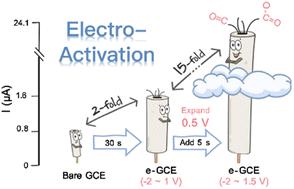当前位置:
X-MOL 学术
›
Anal. Methods
›
论文详情
Our official English website, www.x-mol.net, welcomes your feedback! (Note: you will need to create a separate account there.)
Subtle adjustment of the cyclic potential on electro-activated glassy carbon electrodes for sensitive sensing of methyl parathion
Analytical Methods ( IF 3.1 ) Pub Date : 2024-03-23 , DOI: 10.1039/d4ay00079j Yunyin Yang 1 , Sian Chen 1 , Changqiu Zhang 1 , Yanqing Li 1 , Xinrong Zong 1 , Yitao Lv 1 , Min Zhang 1
Analytical Methods ( IF 3.1 ) Pub Date : 2024-03-23 , DOI: 10.1039/d4ay00079j Yunyin Yang 1 , Sian Chen 1 , Changqiu Zhang 1 , Yanqing Li 1 , Xinrong Zong 1 , Yitao Lv 1 , Min Zhang 1
Affiliation

|
Facile electro-activated glassy carbon electrodes (e-GCEs), which are prepared in electrolyte solution with a certain potential for a few seconds, have been verified to improve analytical performance toward not a few electro-active molecules recently. Nevertheless, how and why the potential plays an important role is not clear, and has even not received enough consideration. In this paper, we found that the mode and the range of applied potential significantly impacted the sensitivity of methyl parathion (MP), which is a typical pesticide with the electro-active group of –NO2. Compared with constant potential, the e-GCE with cyclic potential provided a much more stable baseline during MP detection. Additionally, the electro-oxidation peak current of MP at around −0.1 V on it was higher than another changeable potential (constant current). What's more interesting, with cyclic potential for 50 segments from −2 to 1.5 V, the peak current value increased by 30 times in comparison with a bare GCE, but only 2 times from −2 to 1 V. Then after systematic investigation including structures of the electrode surface and functional groups, we speculated that the produced group of O–C![[double bond, length as m-dash]](https://www.rsc.org/images/entities/char_e001.gif) O in the process of activation and remaining groups of C–O and C
O in the process of activation and remaining groups of C–O and C![[double bond, length as m-dash]](https://www.rsc.org/images/entities/char_e001.gif) O on the bare GCE surface are beneficial for adsorbing MP molecules leading to enhanced peak current. Employing the proposed e-GCE, the limit of detection of MP reached 0.015 μM and the reproducibility was perfect. This work elucidates the potent impact of electro-activation potential parameters on electroanalysis behaviors.
O on the bare GCE surface are beneficial for adsorbing MP molecules leading to enhanced peak current. Employing the proposed e-GCE, the limit of detection of MP reached 0.015 μM and the reproducibility was perfect. This work elucidates the potent impact of electro-activation potential parameters on electroanalysis behaviors.
中文翻译:

微妙调整电激活玻碳电极的循环电位以灵敏传感甲基对硫磷
最近,在一定电位的电解质溶液中制备简便的电激活玻碳电极(e-GCE)几秒钟已被证实可以提高对不少电活性分子的分析性能。然而,潜力如何以及为何发挥重要作用尚不清楚,甚至没有得到足够的考虑。在本文中,我们发现施加电位的模式和范围显着影响甲基对硫磷(MP)的敏感性,甲基对硫磷是一种典型的带有–NO 2电活性基团的农药。与恒定电位相比,循环电位的 e-GCE 在 MP 检测过程中提供了更加稳定的基线。此外,MP在-0.1 V左右的电氧化峰值电流高于另一种可变电位(恒流)。更有趣的是,在-2至1.5 V的50段循环电位下,与裸GCE相比,峰值电流值增加了30倍,但从-2至1 V仅增加了2倍。然后经过系统研究,包括结构通过对电极表面和官能团的观察,我们推测![[双键,长度为m-破折号]](https://www.rsc.org/images/entities/char_e001.gif) 活化过程中产生的O-C O基团以及
活化过程中产生的O-C O基团以及![[双键,长度为m-破折号]](https://www.rsc.org/images/entities/char_e001.gif) 裸露的GCE表面上残留的C-O和C O基团有利于吸附MP分子,从而导致峰值电流增强。采用所提出的 e-GCE,MP 的检测限达到 0.015 μM,并且重现性良好。这项工作阐明了电活化电位参数对电分析行为的潜在影响。
裸露的GCE表面上残留的C-O和C O基团有利于吸附MP分子,从而导致峰值电流增强。采用所提出的 e-GCE,MP 的检测限达到 0.015 μM,并且重现性良好。这项工作阐明了电活化电位参数对电分析行为的潜在影响。
更新日期:2024-03-23
![[double bond, length as m-dash]](https://www.rsc.org/images/entities/char_e001.gif) O in the process of activation and remaining groups of C–O and C
O in the process of activation and remaining groups of C–O and C![[double bond, length as m-dash]](https://www.rsc.org/images/entities/char_e001.gif) O on the bare GCE surface are beneficial for adsorbing MP molecules leading to enhanced peak current. Employing the proposed e-GCE, the limit of detection of MP reached 0.015 μM and the reproducibility was perfect. This work elucidates the potent impact of electro-activation potential parameters on electroanalysis behaviors.
O on the bare GCE surface are beneficial for adsorbing MP molecules leading to enhanced peak current. Employing the proposed e-GCE, the limit of detection of MP reached 0.015 μM and the reproducibility was perfect. This work elucidates the potent impact of electro-activation potential parameters on electroanalysis behaviors.
中文翻译:

微妙调整电激活玻碳电极的循环电位以灵敏传感甲基对硫磷
最近,在一定电位的电解质溶液中制备简便的电激活玻碳电极(e-GCE)几秒钟已被证实可以提高对不少电活性分子的分析性能。然而,潜力如何以及为何发挥重要作用尚不清楚,甚至没有得到足够的考虑。在本文中,我们发现施加电位的模式和范围显着影响甲基对硫磷(MP)的敏感性,甲基对硫磷是一种典型的带有–NO 2电活性基团的农药。与恒定电位相比,循环电位的 e-GCE 在 MP 检测过程中提供了更加稳定的基线。此外,MP在-0.1 V左右的电氧化峰值电流高于另一种可变电位(恒流)。更有趣的是,在-2至1.5 V的50段循环电位下,与裸GCE相比,峰值电流值增加了30倍,但从-2至1 V仅增加了2倍。然后经过系统研究,包括结构通过对电极表面和官能团的观察,我们推测
![[双键,长度为m-破折号]](https://www.rsc.org/images/entities/char_e001.gif) 活化过程中产生的O-C O基团以及
活化过程中产生的O-C O基团以及![[双键,长度为m-破折号]](https://www.rsc.org/images/entities/char_e001.gif) 裸露的GCE表面上残留的C-O和C O基团有利于吸附MP分子,从而导致峰值电流增强。采用所提出的 e-GCE,MP 的检测限达到 0.015 μM,并且重现性良好。这项工作阐明了电活化电位参数对电分析行为的潜在影响。
裸露的GCE表面上残留的C-O和C O基团有利于吸附MP分子,从而导致峰值电流增强。采用所提出的 e-GCE,MP 的检测限达到 0.015 μM,并且重现性良好。这项工作阐明了电活化电位参数对电分析行为的潜在影响。



























 京公网安备 11010802027423号
京公网安备 11010802027423号